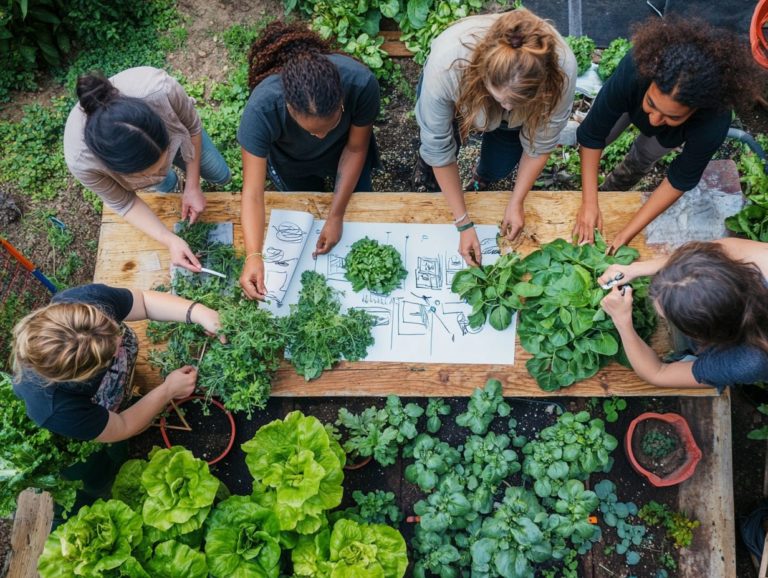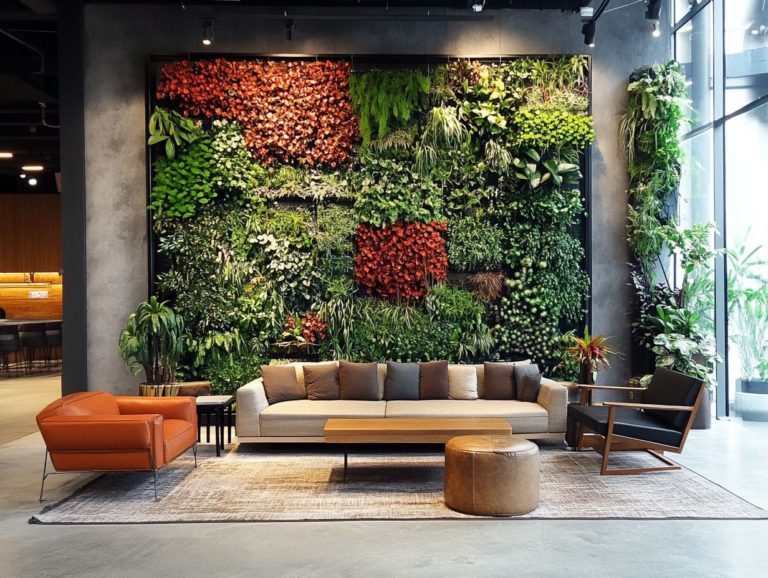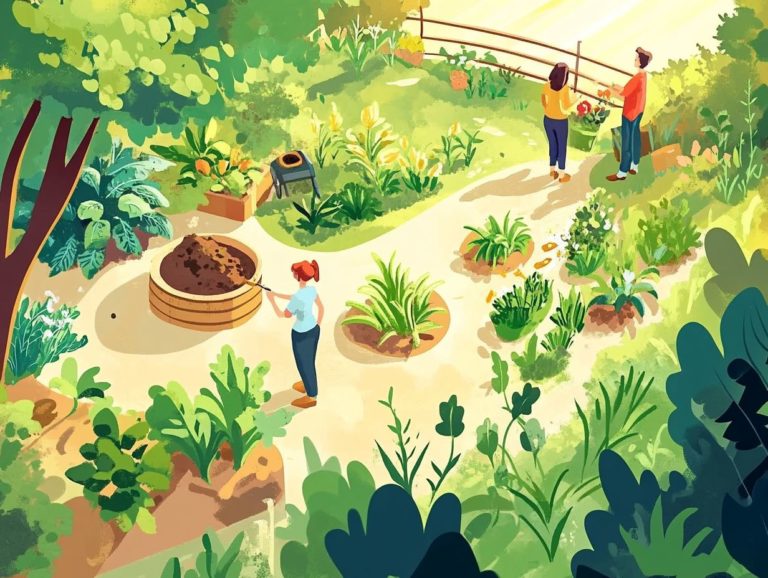The Power of Community in Permaculture Design
Permaculture design goes beyond farming; it’s a holistic approach to crafting sustainable ecosystems that enrich both the environment and local communities, fostering a thriving sustainable society.
This discussion uncovers the core principles of permaculture, highlighting the essential role community involvement plays in its success, particularly through community design and participatory culture. You ll discover the benefits and challenges of collaboration and effective communication strategies that show how inclusive practices nurture resilience and creativity, vital for building community.
Through real-life case studies, you will find inspiring examples of community-driven permaculture projects, such as community gardens and food forests, that could serve as models for your initiatives. Join us as we explore the transformative power of community in permaculture design, emphasizing the importance of relational networks and neighborhood connections!
Contents
- Key Takeaways:
- Understanding Permaculture Design
- The Role of Community in Permaculture
- Collaborative Design Processes
- Community Building in Permaculture Projects
- Case Studies of Successful Community Permaculture Designs
- Frequently Asked Questions
- What is the power of community in permaculture design and how does it relate to community design?
- How does community involvement benefit permaculture design?
- Can community involvement help with the implementation of permaculture design?
- How can community involvement enhance the social aspect of permaculture design?
- What are some examples of community involvement in permaculture design?
- How can you get involved in permaculture design within your community?
Key Takeaways:
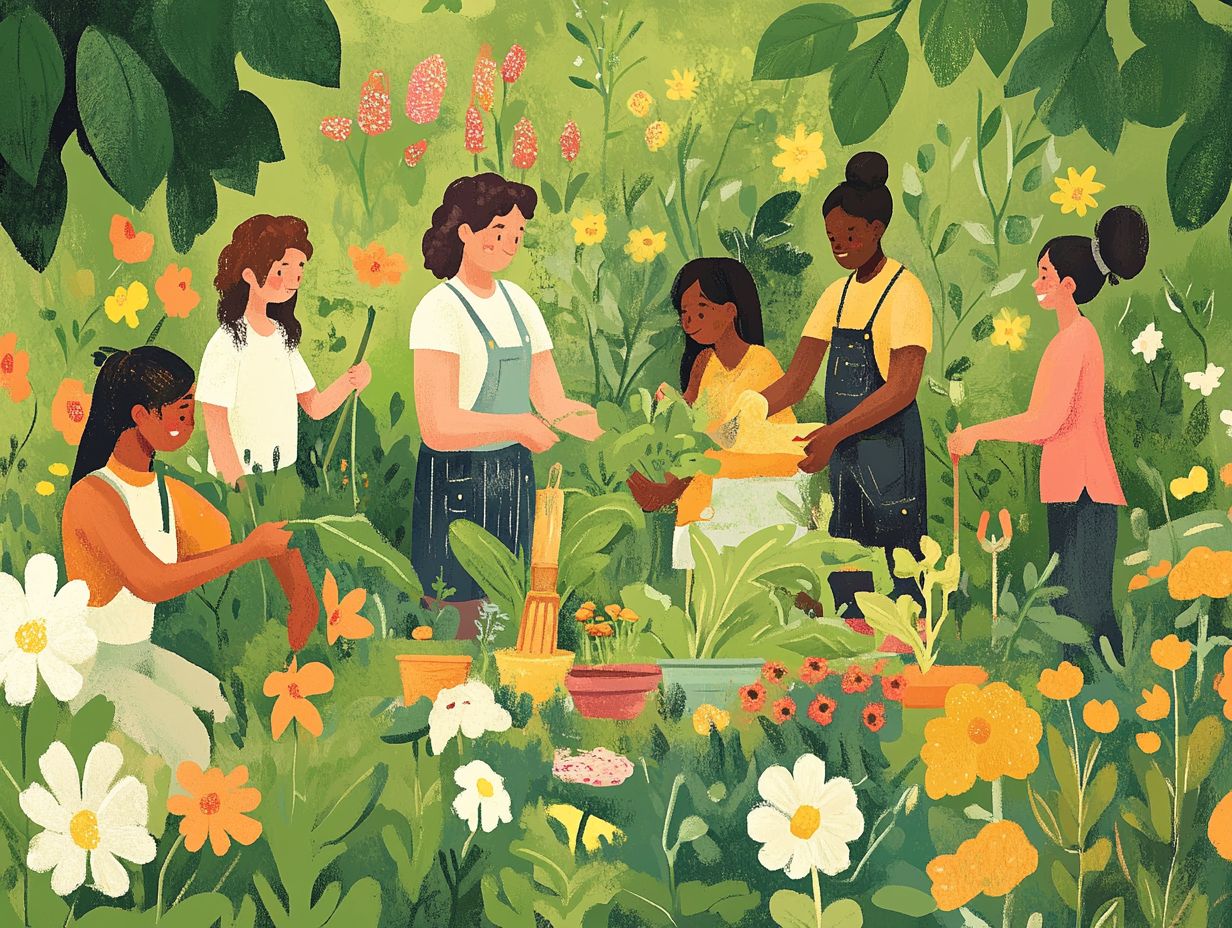
- Community involvement is key to success in permaculture designs, bringing diverse perspectives, skills, and resources to public and shared spaces.
- Effective communication and decision-making processes are essential for successful collaboration in permaculture design projects, particularly in urban environments.
- Incorporating inclusive and sustainable community building practices is crucial for creating long-lasting and resilient permaculture projects, integrating ideas from indigenous cultures and contemporary architecture firms.
Understanding Permaculture Design
Grasping the nuances of permaculture design is vital for cultivating sustainable systems that align with natural ecosystems and tackle pressing social issues found in urban landscapes. This highlights the significance of urban permaculture. This approach weaves together various design principles grounded in ecological design, integrating wisdom from indigenous cultures, community resources, and innovative design methods.
Influential thinkers like Mark Lakeman, Bill Mollison, and David Holmgren have significantly shaped this framework, prioritizing permaculture education, sustainable living, and resilient settlement patterns. This helps develop design literacy among practitioners. Embracing these concepts enables you to contribute meaningfully to a more harmonious and sustainable world, promoting the importance of community engagement.
Definition and Principles
Permaculture is a holistic design approach that seamlessly integrates land, resources, people, and the environment for sustainable living, using principles from ecological design and natural building. This innovative method places a premium on ethics, underscoring the importance of caring for the earth and all its inhabitants, ensuring every effort contributes to a thriving ecosystem.
By embracing the principles of fair share, permaculture encourages equitable distribution of resources, fostering a strong sense of community among practitioners and advocating local democracy. Aligning these principles with local resources strengthens connections within neighborhoods, promoting local democracy and enabling individuals to actively engage in decision-making processes, essential for community projects.
Ultimately, this approach not only nurtures the environment but also cultivates robust social ties, leading to resilient communities that thrive through collaborative and inclusive practices.
The Role of Community in Permaculture
The role of community in permaculture is pivotal. Your collective efforts cultivate a participatory culture that addresses social issues, builds resilient neighborhoods, and supports environmental impact assessments.
By actively engaging in community projects, you can deepen your connections and share valuable resources. This reinforces the significance of social capital in urban permaculture practices and enhances community engagement.
Benefits of Community Involvement
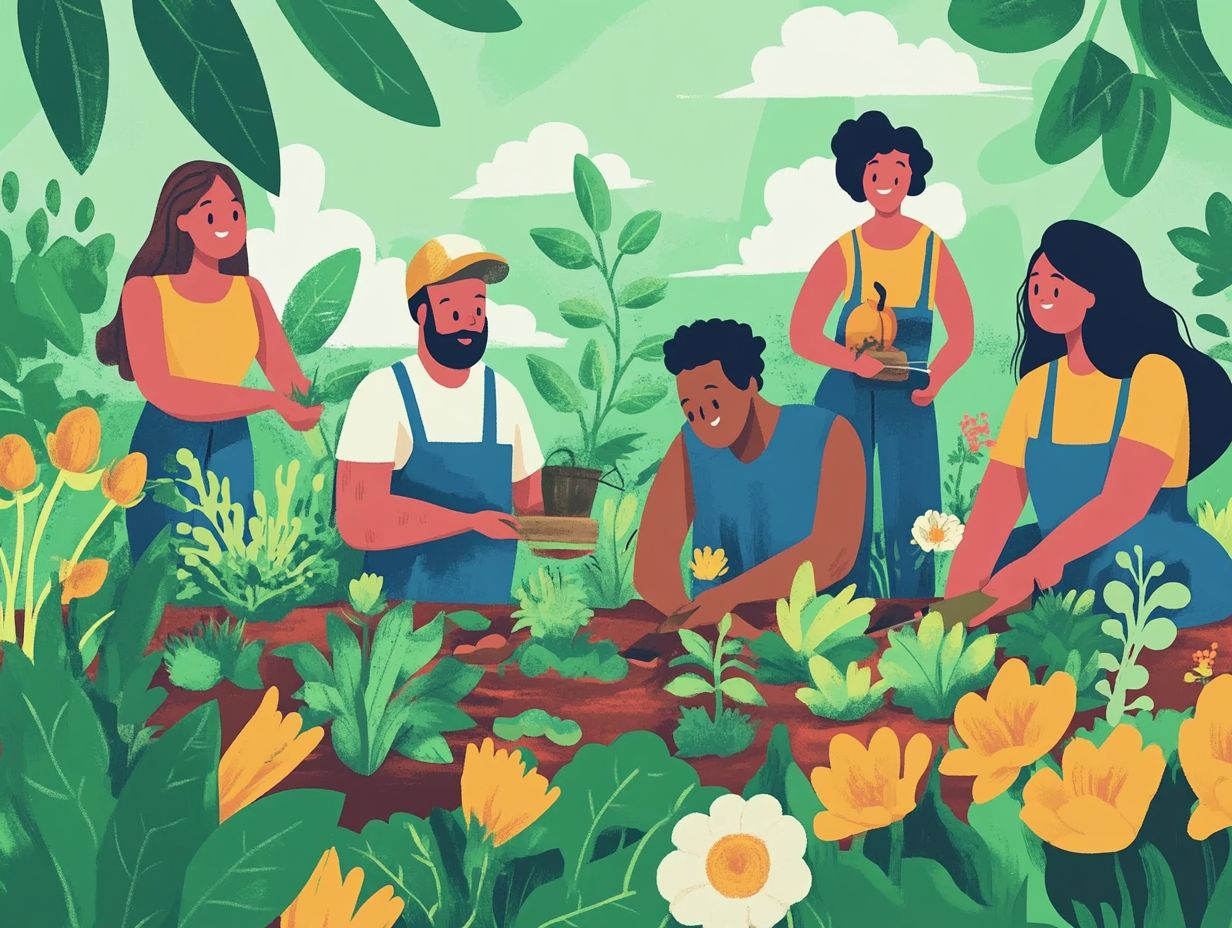
Community involvement in permaculture offers many benefits. These include strengthened social ties, greater access to community gardens, and a boost for local farms, enhancing neighborhood culture.
Participating in these initiatives improves your mental well-being. It also boosts design literacy through shared experiences.
Working with like-minded individuals and forming friendships is incredibly rewarding. You deepen your appreciation for biodiversity through sustainable practices that safeguard local ecosystems.
This collective effort fosters a healthier environment. It also supports local economies by backing farmers markets, cooperatives, and local artisans.
When you collaborate with residents to grow food, you cultivate a profound sense of belonging. This enriches your life and strengthens relational networks.
Challenges and Solutions
Despite the numerous advantages, your involvement in permaculture can encounter challenges related to social dynamics, environmental sustainability, and resource allocation. Effective outreach strategies are necessary.
These obstacles can hinder progress and undermine the potential benefits of community farming projects, especially in urban environments.
For example, social dynamics within your community may create barriers to participation. This results in varying levels of engagement and support, affecting community outreach.
Concerns about environmental impact may surface if projects lack thorough evaluations during their design phases. This emphasizes the need for participatory design involving local communities.
To tackle these challenges, it s essential to embrace participatory design methods that actively involve community members at every stage of the planning process. This fosters an inclusive environment.
By fostering open communication and ensuring that diverse perspectives are acknowledged, you and your group can co-create solutions. This upholds environmental integrity while effectively managing available resources, benefiting community building and design-based strategies.
Collaborative Design Processes
In collaborative design processes within permaculture, effective communication and collective decision-making take center stage. This promotes a strong participatory culture.
This approach ensures that the needs of the community are thoughtfully addressed and met through carefully crafted design strategies that enhance community amenities.
Effective Communication and Decision-Making
Effective communication is essential for making informed decisions in collaborative permaculture design. It promotes transparency and inclusivity among all stakeholders, thereby enhancing design literacy.
By adopting a variety of communication methods like workshops, forums, and social media outreach you can significantly enhance your community’s participatory culture and reach a wider audience.
Workshops offer hands-on experiences that encourage active participation. They allow individuals to contribute their unique ideas and skills, fostering community building.
Meanwhile, forums serve as a platform for open dialogue. Community members can voice concerns and gather valuable insights, promoting neighborhood connections.
Social media outreach amplifies this interaction, connecting a broader audience. It makes it easier for people from diverse backgrounds to engage, enriching the community culture.
These strategies not only empower individuals but also ensure that decision-making processes are more effective. They reflect community needs and foster collaborative solutions that enhance local democracy.
Community Building in Permaculture Projects
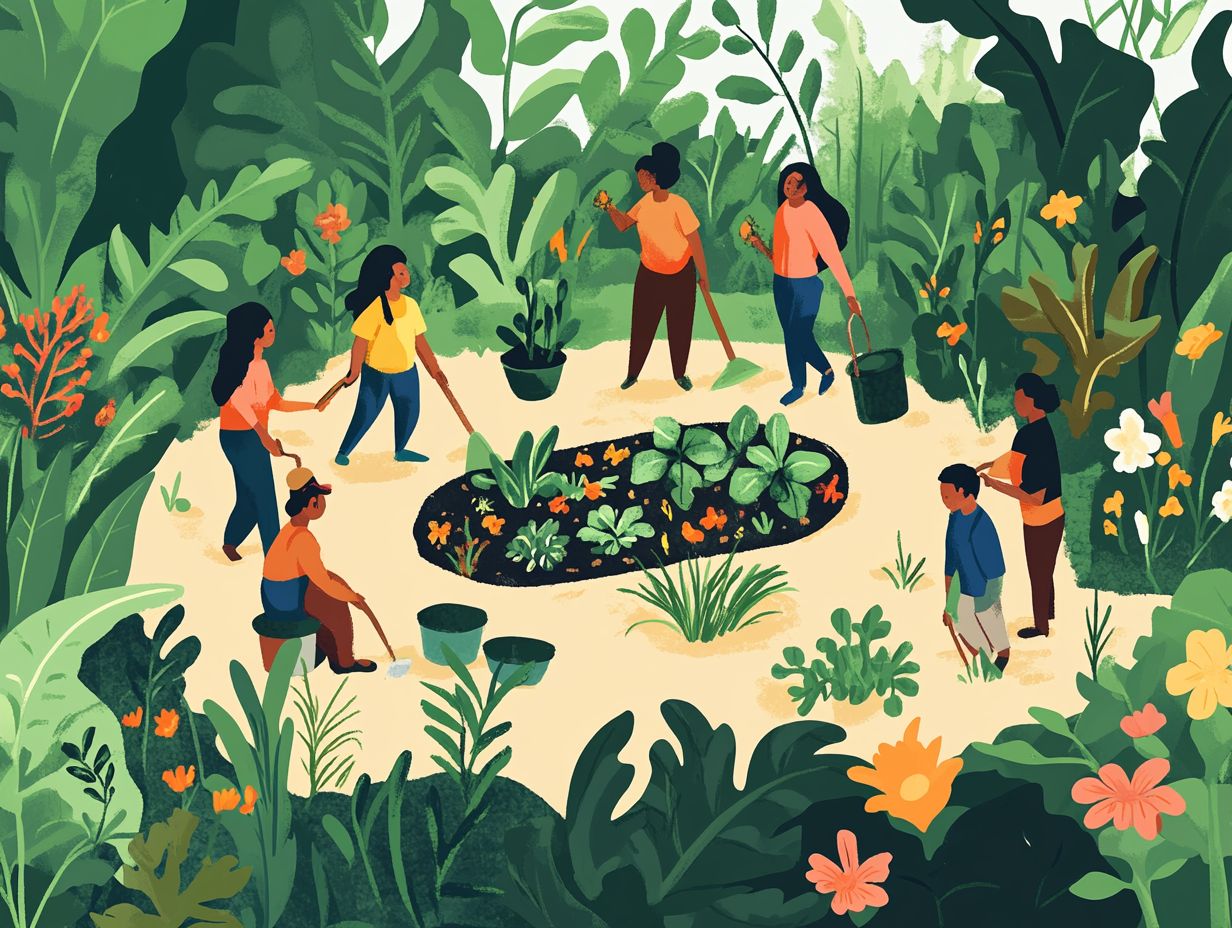
In permaculture projects, community building focuses on creating inclusive and sustainable practices. These enhance social networks and cultivate a deep sense of belonging through shared spaces.
Developing shared areas fosters connections that enrich the entire community. This creates a vibrant environment for all and strengthens neighborhood culture.
Inclusive and Sustainable Practices
Inclusive practices ensure that diverse voices are respected in community permaculture efforts. They prioritize cultural spaces and social initiatives.
Engaging community members from local gardeners to urban planners creates a rich mix of ideas and solutions. Hosting workshops and discussion forums lets everyone share their unique experiences.
Mentorship programs promote knowledge exchange. They help newcomers feel valued, strengthening community ties.
This transformation enriches neighborhood culture and nurtures a participatory spirit that benefits everyone involved.
Case Studies of Successful Community Permaculture Designs
Exploring case studies of successful community permaculture designs reveals the power of targeted planning methods. These methods can transform local ecosystems and social structures, showcasing the impact of thoughtful architecture.
These examples illustrate both effectiveness and the significant benefits that thoughtful design can bring to a community.
Real-Life Examples and Lessons Learned
Real-life examples of community gardens and permaculture projects highlight essential design strategies. These strategies foster shared areas and effective outreach, showcasing local farms and community amenities.
These initiatives enrich the local ecosystem. They empower residents to take ownership of their environment, showing how strategic planning and collaboration yield remarkable results in community engagement. Imagine a community garden transforming a neglected lot into a vibrant oasis, drawing diverse participants through workshops and social events.
Lessons from such projects emphasize the importance of inclusivity and regular communication. Every voice matters. The success of these initiatives often relies on tailored outreach efforts that leverage local media and word-of-mouth, further engaging community members.
Frequently Asked Questions

What is the power of community in permaculture design and how does it relate to community design?
The power of community in permaculture design means individuals working together can create a more sustainable system than working alone. It involves sharing resources, knowledge, and skills for a mutually beneficial permaculture design.
How does community involvement benefit permaculture design?
Community involvement brings diverse perspectives and skills. This leads to a more well-rounded and effective design. It fosters a sense of ownership and shared responsibility, promoting better maintenance and sustainability in the long run.
Can community involvement help with the implementation of permaculture design?
Yes, community involvement can greatly aid in the implementation of permaculture design.
Involving community members provides more hands and resources for tasks like building structures and planting. This approach can reduce costs and increase efficiency.
Community involvement in permaculture design fosters a sense of connection and shared purpose among individuals, especially when considering the role of plants in permaculture design.
It provides opportunities for social interaction, learning, and cooperation, leading to a stronger and more supportive community.
What are some examples of community involvement in permaculture design?
Examples of community involvement include community gardens, eco-villages, co-housing projects, and community-supported agriculture.
These initiatives involve individuals coming together to create and maintain sustainable and regenerative systems that benefit the community as a whole.
How can you get involved in permaculture design within your community?
You can dive into permaculture design by joining local initiatives or even starting your own adventure!
Attend workshops, classes, and events to learn more about permaculture principles and connect with like-minded individuals.
Volunteering or interning at a permaculture site is also a fantastic way to gain hands-on experience and contribute to a community project.
Join a workshop today and connect with passionate individuals who share your vision for a sustainable future!


